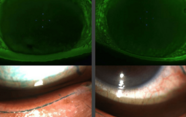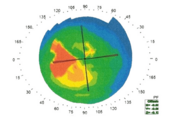
ARVO in Focus: “Stair-Gazing” and Food for the Eyes
Keep up to date with the latest research from ARVO journals through our research breakdown
New to The Ophthalmologist? Sign up for our newsletter, print or digital issue

People illustrations credit: Shutterstock.com
Stair-Gazing
Where do we look when we walk up and down staircases with which we are familiar? Researchers conducted a frame-by-frame analysis of 30 participants engaging in a navigation task in their own houses whilst wearing glasses containing a wearable eye tracker and camera (1). Their findings demonstrate that people often look at familiar steps sequentially, on average directing their gaze at about half of the steps. Their results echo previous studies conducted under constrained lab conditions, whilst also introducing new analysis for better understanding stair-climbing gaze behavior.
Food for the Eyes
To determine the associations between fatty acid intake and the prevalence of age-related macular degeneration (AMD) under a population-based cross-sectional study, researchers conducted eye screening on residents of Chikusei City in Japan (2). Although saturated fatty acid intake was inversely associated with the prevalence of AMD in men, only a significant association was observed between the second quartile of linolenic acid intake and the prevalence of any AMD in women.
BKC Breakdown
A multi-institutional study screened and compared the proteomic make up of meibomian gland secretions between blepharokeratoconjunctivitis (BKC) patients and healthy individuals to identify target proteins potentially involved in the onset and progression of BKC. BKC patients had significantly lower eyelid margin cleanliness, higher palpebral margin scores, more serious clinical manifestations of secretions, and more damaged meibomian gland morphology compared with the healthy controls (3). S100A8, S100A9, ANXA3, and LCN2 were identified as BKC-associated proteins probably involved in the chronic inflammation of BKC.
Dry-Eyed Dogs
Researchers from the Department of Oral and Maxillofacial Surgery at Peking University School and Hospital of Stomatology have developed a Beagle dog model of dry eye disease (4). They found that a combined type of DED model was established through the removal of the orbital lacrimal gland and resection of the third eyelid. The authors conclude that the model is easily accessible and stable at six-month observation.
- A Ghiani et al., J Vis, 23, 7 (2023). PMID: 36633872.
- T Yasukawa et al., Transl Vis Sci Technol, 12, 3 (2023). PMID: 36595278.
- J Su et al., Transl Vis Sci Technol, 11, 4 (2022). PMID: 36458945.
- Z Li et al., Transl Vis Sci Technol, 12, 2 (2023). PMID: 36595279.
I have always been fascinated by stories. During my biomedical sciences degree, though I enjoyed wet lab sessions, I was truly in my element when sitting down to write up my results and find the stories within the data. Working at Texere gives me the opportunity to delve into a plethora of interesting stories, sharing them with a wide audience as I go.











